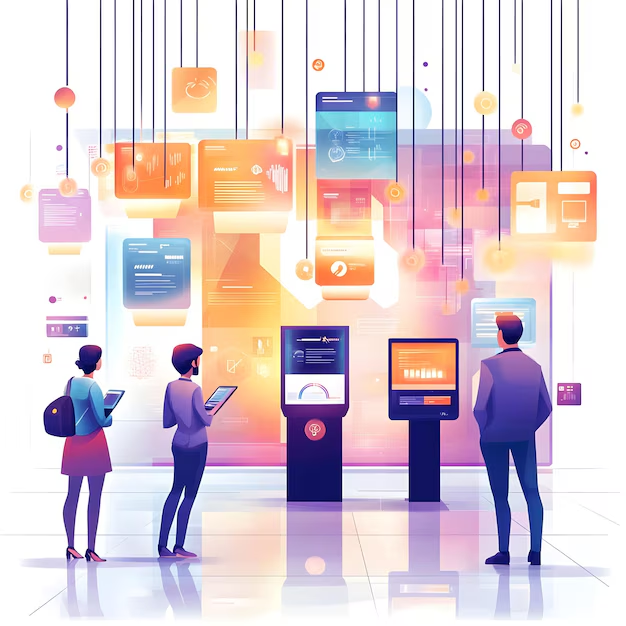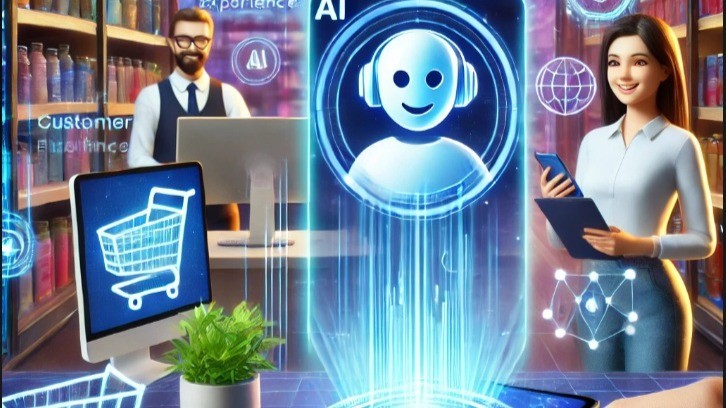Discover how AI-Driven Customer Experience is transforming business interactions with personalization, predictive analytics, real-time support, and customer journey optimization. Learn key components, benefits, and trends shaping the future of AI-powered CX.

AI-Driven Customer Experience: Transforming Business Interactions with Artificial Intelligence
In the digital era, customers expect fast, personalized, and seamless interactions across every touchpoint. This shift has pushed businesses to adopt AI-Driven Customer Experience strategies that enhance personalization, predictive insights, real-time support, and end-to-end journey optimization.
Today, Artificial Intelligence (AI) and Machine Learning (ML) have become core enablers of smarter, data-led decision-making that elevates every step of the customer journey.
-
Introduction – The Rise of AI-Driven Customer Experience
-
How AI is Transforming Customer Experience
-
AI-Powered Personalization
-
Predictive Analytics and Insights
-
Real-Time Support with Chatbots & Voice AI
-
Customer Journey Optimization
-
-
Key Components of AI-Driven Customer Experience
-
Strategic Benefits for Enterprises
-
Industry Use Cases
-
Emerging Trends in AI-Driven CX
-
Best Practices for Implementing AI in CX
-
Future Outlook of AI in Customer Experience
-
Conclusion
Introduction – The Rise of AI in Customer Experience
In the digital era, customer expectations have evolved dramatically. Consumers demand personalized, fast, and seamless experiences across channels. Businesses striving to meet these expectations are increasingly turning to AI-driven Customer Experience (CX) strategies.
Artificial Intelligence (AI) and Machine Learning (ML) are revolutionizing how organizations collect, interpret, and act upon customer data. By leveraging AI, businesses can anticipate customer needs, respond in real-time, and deliver hyper-personalized experiences at scale. From AI-powered chatbots to predictive analytics engines, companies now have the tools to optimize interactions across the entire customer journey.
How AI is Transforming Customer Experience
AI-Powered Personalization
Personalization is no longer optional; it is a necessity. AI enables businesses to analyze vast datasets, identify patterns, and deliver individualized content, product recommendations, and offers.
For example, Netflix uses AI algorithms to suggest movies and shows based on viewing history, while Amazon predicts product preferences using real-time behavior analytics. This level of personalization drives engagement, loyalty, and sales.
Predictive Analytics and Customer Insights
AI-driven predictive analytics helps businesses anticipate customer behavior and preferences. By analyzing historical data, transaction patterns, and engagement metrics, AI can forecast trends and optimize decision-making.
Banks, for instance, use predictive models to identify potential churn or fraudulent activity, allowing proactive measures that safeguard both the customer and the organization.
Real-Time Support with Chatbots and Voice Assistants
AI-powered chatbots and voice assistants are transforming customer service. These tools provide instant support, resolve common issues, and route complex inquiries to human agents.
Companies like Sephora use chatbots to assist with product selection, while Bank of America’s Erica virtual assistant helps customers manage finances efficiently. Real-time AI support reduces response times, enhances customer satisfaction, and lowers operational costs.
Customer Journey Optimization
AI monitors and analyzes the entire customer journey across touchpoints, identifying friction points and recommending improvements. Tools like Adobe Experience Platform leverage AI to optimize engagement, content placement, and timing.
By continuously learning from user behavior, AI ensures that every interaction is relevant, timely, and frictionless.
Key Components of AI-Driven CX

AI Chatbots
AI chatbots provide automated, 24/7 customer service. They handle FAQs, guide users through processes, and escalate complex issues to human agents.
Benefits:
- Reduces response time
- Improves customer satisfaction
- Reduces operational costs
Example: H&M’s chatbot helps customers find clothing items and check availability, improving online shopping efficiency.
Recommendation Engines
Recommendation engines use AI to suggest products, content, or services tailored to individual users. They analyze historical data, purchase patterns, and preferences to maximize relevance.
Example: Spotify’s Discover Weekly playlist curates songs based on listening habits, increasing user engagement.
Sentiment Analysis
AI-powered sentiment analysis evaluates customer emotions from reviews, social media, or surveys. This insight helps companies respond proactively to negative feedback and reinforce positive experiences.
Example: Airlines monitor sentiment on social media to address complaints instantly and enhance passenger satisfaction.
Voice Assistants and Conversational AI
Voice-activated AI assistants, like Siri, Alexa, and Google Assistant, facilitate natural language interactions, allowing users to perform tasks hands-free.
Business Use: Retailers implement voice search features to improve product discovery and checkout processes.
Automated Feedback Loops
AI collects and analyzes feedback automatically, detecting patterns in customer behavior. These insights inform product improvements, marketing strategies, and service enhancements.
Example: Hotels use AI-driven feedback to optimize room offerings, amenities, and personalized promotions.
Predictive Modeling for Customer Behavior
Predictive modeling forecasts customer actions, such as churn, repeat purchases, or lifetime value. AI analyzes transactional and behavioral data to guide retention strategies.
Example: E-commerce platforms predict which customers are likely to abandon carts and trigger personalized incentives to complete purchases.
Strategic Benefits for Enterprises >
Improved Customer Satisfaction
AI enables fast, accurate, and personalized interactions, creating seamless experiences that increase satisfaction and loyalty.
Higher Retention and Loyalty
Predictive analytics identifies at-risk customers and allows proactive retention campaigns, strengthening long-term relationships.
Increased Sales and Revenue
Personalized recommendations, dynamic pricing, and timely offers drive higher conversion rates and revenue growth.
Operational Efficiency
Automation of repetitive tasks reduces human workload, improves response times, and lowers operational costs.
Data-Driven Decision Making
AI provides actionable insights from complex datasets, empowering leaders to make informed decisions that enhance CX strategy.
Industry Applications

E-Commerce
AI personalizes product recommendations, optimizes inventory, and predicts customer demand to maximize sales.
Example: Amazon’s AI-driven recommendation engine contributes to over 35% of its revenue.
Banking and Financial Services
Banks leverage AI for fraud detection, personalized financial advice, and predictive customer insights.
Example: JPMorgan Chase uses AI to analyze transactions and detect suspicious activity in real-time.
Healthcare
AI enhances patient engagement through personalized care recommendations, predictive health monitoring, and appointment scheduling.
Example: Babylon Health uses AI chatbots to provide medical consultations and triage.
Telecom
Telecom providers utilize AI for predictive maintenance, churn analysis, and real-time customer support.
Example: Vodafone implements AI chatbots for customer queries and troubleshooting.
Retail
AI optimizes inventory, predicts trends, and delivers personalized marketing campaigns.
Example: Starbucks uses AI for personalized offers based on purchase history and location.
Emerging Trends in AI-Driven CX
Generative AI for Customer Engagement
Generative AI creates personalized content, emails, and interactive experiences to boost engagement.
Hyper-Personalization
AI uses deep learning and real-time analytics to deliver content, offers, and recommendations tailored to individual users.
Ethical AI in Customer Interactions
Ethical AI ensures transparency, fairness, and privacy in customer interactions, safeguarding trust and brand reputation.
Best Practices for Implementing AI in CX
- Start Small: Begin with pilot projects before scaling.
- Prioritize Data Quality: AI success depends on clean, structured, and diverse datasets.
- Integrate Across Channels: Ensure AI solutions work seamlessly across web, mobile, and in-store.
- Monitor and Adjust: Continuously evaluate AI performance and refine models.
- Maintain Transparency: Communicate AI-driven decisions clearly to customers to build trust.
Future Outlook

The future of AI-driven CX includes:
- Predictive Experiences: AI anticipating customer needs before they arise.
- Omnichannel Integration: Unified experiences across all touchpoints.
- Explainable AI: Transparent AI decision-making that builds trust.
- Evolving CX Roles: Human CX professionals focusing on strategy, creativity, and empathy, while AI handles routine and predictive tasks.
Conclusion
AI-driven Customer Experience is no longer optional; it’s a strategic imperative. By leveraging AI and ML, businesses can deliver hyper-personalized, predictive, and seamless interactions that improve satisfaction, loyalty, and revenue. From chatbots to predictive analytics, AI empowers enterprises to understand customers deeply, optimize operational efficiency, and drive data-driven strategies across industries.
Integrating AI into CX requires careful planning, ethical considerations, and ongoing monitoring, but the rewards are substantial. The future will see AI as a core enabler of predictive, omnichannel experiences, transforming the way businesses interact with customers while redefining the role of human CX professionals.


